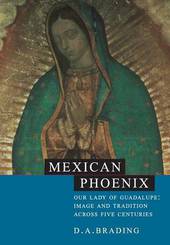
|
Mexican Phoenix: Our Lady of Guadalupe: Image and Tradition across Five Centuries
Paperback / softback
Main Details
Description
Juan Diego, to whom the Virgin Mary appeared in 1531 miraculously imprinting her likeness on his cape, was canonised in Mexico in 2002 by Pope John Paul II. In 1999, the revered image of Our Lady of Guadalupe had been proclaimed patron saint of the Americas by the Pope. How did a poor Indian and a sixteenth-century Mexican painting of the Virgin Mary attract such unprecedented honours? Across the centuries the enigmatic power of the image has aroused fervent devotion in Mexico: it served as the banner of the rebellion against Spanish rule and, despite scepticism and anti-clericalism, still remains a potent symbol of the modern nation. This book traces the intellectual origins, the sudden efflorescence and the adamantine resilience of the tradition of Our Lady of Guadalupe and will fascinate anyone concerned with the history of religion and its symbols.
Author Biography
David Brading is Professor of Mexican History, University of Cambridge.
Reviews'... definitive ... Mexican Phoenix is incomparably the most complete and reliable study to have appeared on the Guadalupan tradition hitherto.' The Times Literary Supplement '... a careful chronology of the Guadalupe tradition and a record of the rich theological reflection it has inspired over five centuries ... the most thorough and balanced treatment available anywhere.' The Tablet 'Brading recounts in detail the many struggles round this fascinating cult, whose authority just grows as its authenticity diminishes.' New York Times 'This magnificent study ... is a careful chronology of the Guadalupe tradition and a record of the rich theological reflection it has inspired over five centuries - which amounts to a Mexican, even American, salvation history.' Austen Ivereigh, The Tablet '... a supremely important book ... due to take its place among the standard treatments of Guadalupe.' Catholic Historical Review This is a topic of central importance in the Mexican collective imagination, by the author of The First America. In a massive book supported by equally massive scholarship Professor Brading focuses on the interpretation of the image of Our Lady of Guadalupe over the centuries, from the devout to the sceptical or iconoclastic. The strength of the book lies in its scholarship, its clarity, its judicious comments, and above all in the way it cuts across cultural and political history, the colonial period, and the nineteenth and twentieth centuries.' Peter Burke, University of Cambridge 'Brading's treatment is informative, original, and interestingly laid out. His book has a compellingly-realized dramatic structure which makes the reader want to know 'how the story comes out', while the discussion of abstruse points in theology and intellectual history is enlivened by gripping and often sympathetic biographical portraits, by deep readings of canonical texts, and by a mastery of contemporary debates. It makes a vital contribution to the study of modern Mexican culture and religious life.' Eric Van Young, University of California, San Diego '... a compelling theological, intellectual, cultural and political history of the powerful image and tradition of Our Lady of Guadalupe in Mexico.' Sixteenth Century Journal '... Mexican Phoenix offers the results of substantiated and well-documented research. The volume will appeal the the specialists in many fields of Latin American studies, while translated quotations and clear, vivid narration will make this intriguing study accessible to a wider audience.' Bulletin of Hispanic Studies 'Brading recounts in detail the many struggles around this fascinating cult, whose authority just grows as its authenticity diminishes.' The New York Times Book Review '... a solid, meticulously-written study ... Mexican Phoenix gives its readers expert, thorough and balanced coverage of her documentary history from which to pursue many different lines of inquiry'. Journal of Ecclesiastical History
|